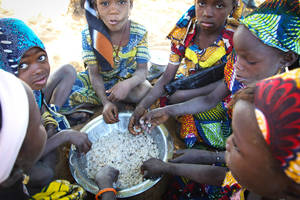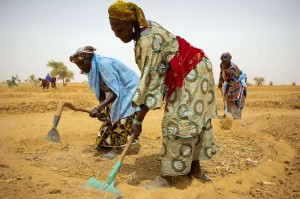How Do Rising Harvests Equal Increasing Food Insecurity?
Dec 13th, 2013 | By admin | Category: Food and Hunger/AgricultureBy Suzanne York, www.howmany.org
Alarmingly, food insecurity in Africa’s Sahel belt continues to worsen. This week the United Nations reported that 16 million people in the region are at risk of going hungry in the next year due to violent conflicts and rapid population growth.
The Sahel encompasses a semiarid strip of land in Sub-Saharan Africa south of the Sahara Desert.
The Impact of Population GrowthEven though this year’s harvest has been better than in past years, food insecurity is projected to increase in 2014 by 40 percent compared to 2013.
According to Robert Piper of the UN Office for the Coordination of Humanitarian Affairs (OCHA), “Rapid population growth has meant the same amount of food has to feed more mouths. So despite a small increase in overall food production, on average there is 13 percent less food per person.”
Conflict and climate change are exacerbating the problems in the Sahel and beyond (some experts believe the crisis in Syria is related to the country’s multi-year drought/climate change and high population growth).
In Nigeria, internal violence led the government to declare a state of emergency last May. The UN’s Piper said that “food insecurity in Nigeria is partly to do with the conflict in the north,” where the military is battling insurgents. Nigeria is expected to be the world’s third most populous nation by 2050, with 440 million citizens.
Earlier this year, food experts warned that millions of people could become destitute in Africa (and Asia) as the prices of staple foods more than double, due to extreme temperatures, floods, and droughts. Frank Rijsberman, head of CGIAR, an international organization working on global food security, stated “food production will have to rise 60 percent by 2050 just to keep pace with expected global population increase and changing demand. Climate change comes on top of that.”
Implementing the Best Solutions
There are policies that can be implemented to improve the situation. Briefly, two of them are voluntary family planning and supporting small-scale farming/traditional agriculture in the face of increasingly severe climate changes.
At last month’s International Conference on Family Planningin Ethiopia, Professor Malcom Potts of the Bixby Center for Population, Health and Sustainability at the University of California, Berkeley, noted there are three things that need to be done. These are: 1) improve the contraceptive prevalence rate in the Sahel (and we know to do this), 2) help agricultural communities and pastoralists adapt to climate change; and 3) invest in girls and young women. He went on to say that all three are essential; remove one and all collapse.Dr. Potts was joined by Dr. Eliya Msiyaphazi Zulu from the African Institute for Development Policy. Dr. Zulu said every country in Sahel is project to double its population by 2050. Rapid population growth is compounding the effects of climate change and undermining the capacity of communities to adapt to its adverse effects. What needs to be done, according to Dr. Zulu, is to invest in education and health, provide jobs, adopt an inclusive and people centered development approach, and implement an integrated PHE (population, health and environment) approach to reduce vulnerability to climate change.
There will be more to come in a future post on the benefits of traditional knowledge and farming as a way to confront food insecurity and climate change. As with family planning, there is much that people know how to do that can improve lives even in the most difficult of situations. But it calls for moving past business as usual and finding the political and personal will to implement ideas – both old and new.


